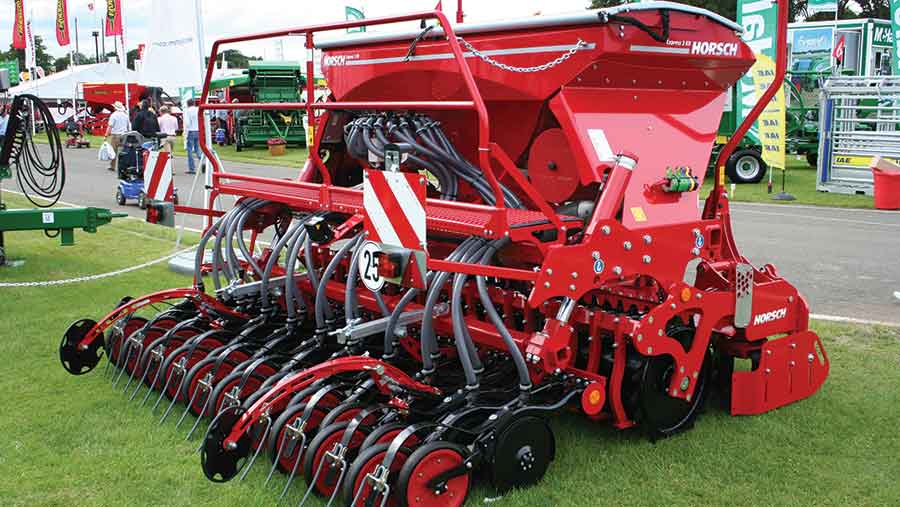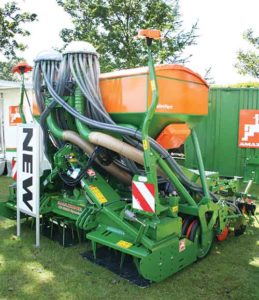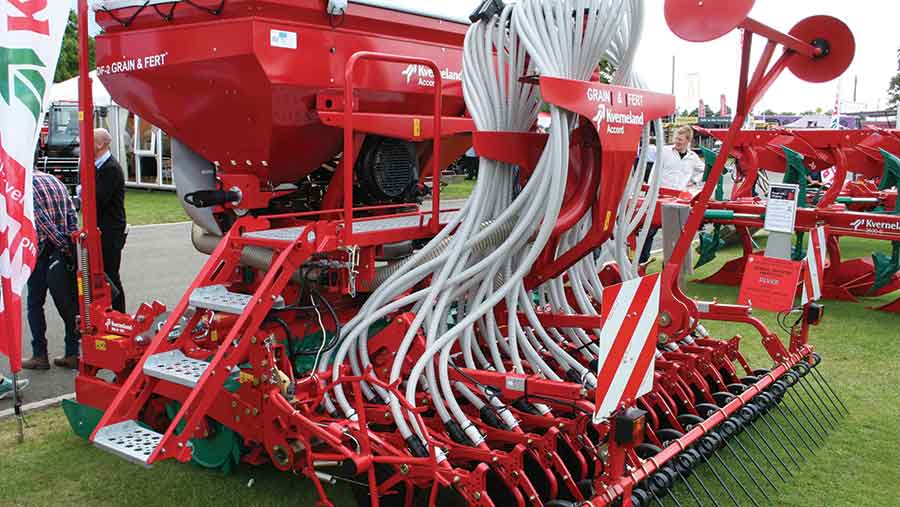New drill options for seed-bed fertiliser

Combi version of the Horsch Express KR one-pass drill and power harrow will have a bigger hopper than the standard outfit and a ‘mix’ unit to deliver both seed and fertiliser to the disc coulters © Peter Hill
New options for growers wanting to apply dry fertiliser when sowing spring cereal crops take different approaches to delivering the material, either down the same spout as the seed or trickled into the seed-bed from a separate distribution set up.
In Scotland and Ireland, the “mix” approach tends to be favoured for spring barley to ensure phosphorous, which is somewhat immobile in the soil moving less than 2mm in a week – can perform its primary function of encouraging strong root development.
Horsch
See also: Farmers can save cash by applying liquid fertiliser at drilling
The “combi” version of the Horsch Express KR piggy-back drill will use the one-shot approach when it becomes available later this year, which mirrors the technique used on “mix” seed and fertiliser versions of the Pronto DC trailed drill.
“The Express KR grain and fertiliser drill will have a 2,000-litre pressurised steel hopper – up from 1,500-litres on the standard machine – with a division giving proportions of around 45:55 and a mixing unit,” explains Steve Burcham of Horsch UK.
The Express KR, which combines Pronto seeder technology with Horsch’s Kredo power harrow, is currently available in 3m sizes with 3.5m and 4m models on their way.
TurboDisc 2 coulters introduced for Pronto drills last year are standard on the one-pass outfit, with four rubber inserts for each coulter arm mounting transferring up to 120kg to each disc.
Amazone

© Peter Hill
The Amazone AD-P Super “C” is a UK project to meet the needs of northern growers wanting to place fertiliser with seed for spring crops.
It involves the standard 1,500- or 2,000-litre capacity hopper being replaced by an alternative 2,000-litre hopper with a bolt-in division and the option of a 500-litre extension.
“Having two outlets, metering kits and distribution systems – both with electric tramlining – means the drill can operate grain only or put down different combinations of seed and fertiliser without any wastage,” points out Adrian Winnett of Amazone.
“Fertiliser is delivered down separate air tubes and released just behind the coulters and a little shallower than the seed.”
The AD-P Super piggy-back drill itself has been refreshed with a larger access platform, roll-over hopper cover, electric metering roller drive, new tramlining system and Isobus compliant electronics.
Kverneland
Kverneland’s solution to creating a combi version of the iDrill one-pass outfit has been to mount an existing hopper – usually mounted on the front of a tractor – on the machine’s frame.
The DF-2 hopper provides 1,500-litre capacity for grain and fertiliser on the Accord DFC, which are metered and distributed separately, with fertiliser dispensed from a tube positioned immediately behind the single disc coulter.

Mounting a standard tractor front hopper on the iDrill creates the new Kverneland Accord DFC with 1,500-litres of grain and fertiliser capacity © Peter Hill
The standard coulter comes with a flexible plastic scraper disc and is followed by a soft press wheel.
Kverneland recommends the NG-S or NG-H power harrows rated for tractors up to 240hp for the outfit; the main difference between the two is the amount of clearance above the tine rotors.
Great Plains
Growers looking for bigger capacity can turn to the new grain and fertiliser versions of the 3m, 4m and 6m Great Plains Centurion and Saxon trailed drills.
The Centurion is used as a cultivator drill after ploughing or stubble cultivation, using two rows of discs to complete a seed-bed ahead of twin disc openers, while the Saxon replaces these with straight fluted discs for minimal soil movement.
“Apart from timeliness of emergence, reduced input costs are among the benefits of placing fertiliser with these drills, either in-line with the seed using a double shoot system or as a side dressing,” says David Holmes of Great Plains.
“Placement at drilling reduces the amount of fertiliser applied and there is less encouragement of weed growth.”
Claydon offers smaller trailed drill
At 4m, the latest addition to the Claydon Hybrid trailed drill range is smaller than the existing 6m and 8m models, but can still come with a 3,500-litre hopper divided 60:40 for placing fertiliser at the same time as sowing grain.
Like the larger models, the newcomer’s chassis and hopper assembly are supported separately from the coulter frame, which runs on seven deep cleated support wheels on dry, undisturbed soil. This means sowing depth is unaffected by the changing weight of seed and/or seed and fertiliser.
Optional press wheels, simple depth wheels or shouldered cutting discs are employed at the front of the drill and a selection of press wheel and harrow configurations can be deployed at the back.
Between them come Claydon’s leading tine and seed coulter combination tilling and drilling a narrow strip of otherwise untouched ground.
Fertiliser is placed via either the soil loosening tine or seed coulter boot from the main hopper, a 65-litre micro-fertiliser hopper, a 1,750-litre tractor-mounted hopper or a 1,000-litre liquid tank.

